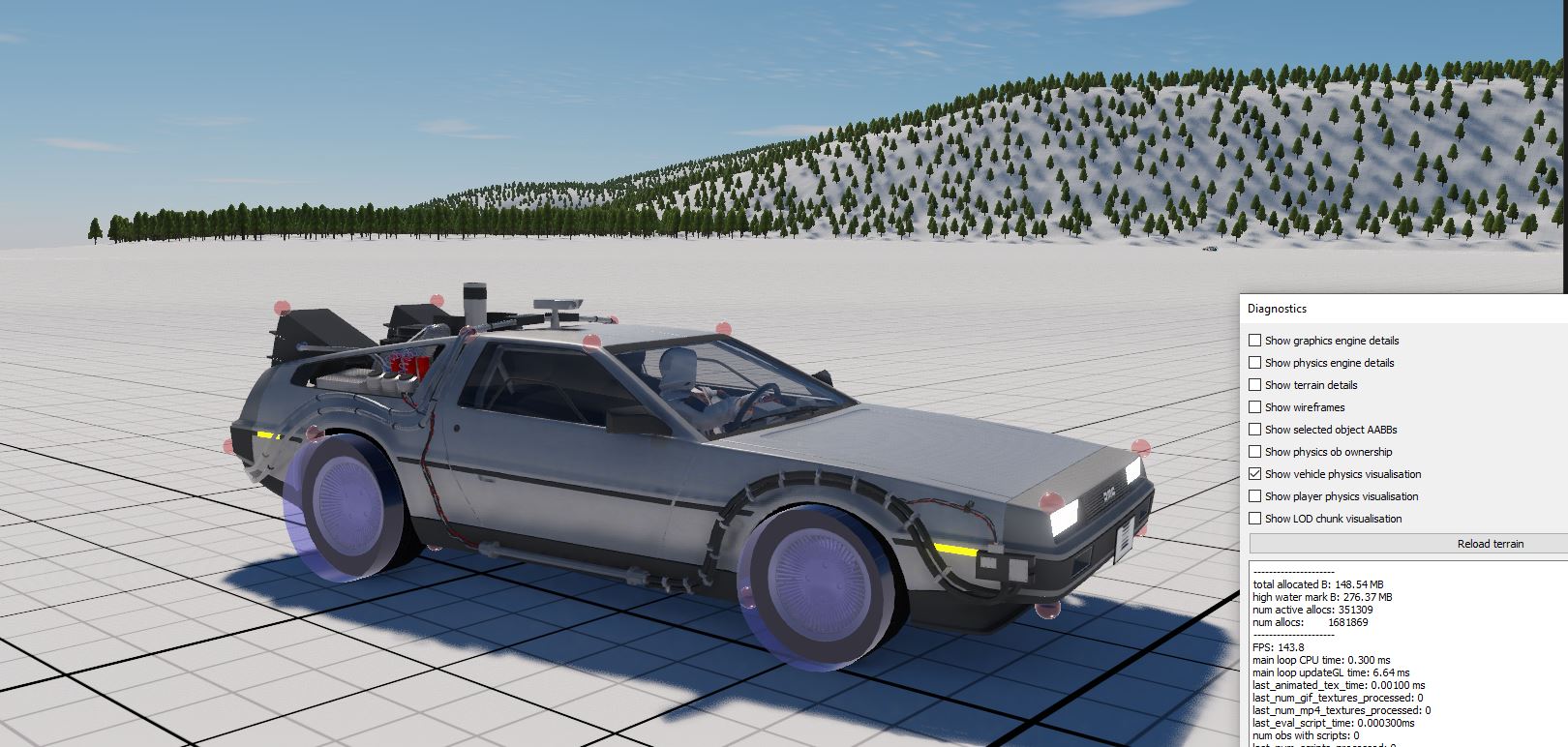
model_to_y_forwards_rot_1: axis-angle 3-vector. See Vehicle scripting for details.
model_to_y_forwards_rot_2: axis-angle 3-vector. See Vehicle scripting for details.
seat: Defines a seat. See Vehicle scripting for details.
front_wheel_radius: radius of the front wheels, in metres.
rear_wheel_radius: radius of the rear wheels, in metres.
front_wheel_width: width of the front wheels (e.g. width of the tire), in metres.
rear_wheel_width: width of the rear wheels (e.g. width of the tire), in metres.
front_suspension_min_length: How long the suspension is in max raised position relative to the attachment point (metres), for front wheels. Default is 0.2.
rear_suspension_min_length: How long the suspension is in max raised position relative to the attachment point (metres), for rear wheels. Default is 0.2.
front_suspension_max_length: How long the suspension is in max droop position relative to the attachment poin (metres), for front wheels. Default is 0.5.
rear_suspension_max_length: How long the suspension is in max droop position relative to the attachment point (metres), for rear wheels. Default is 0.5.
front_wheel_attachment_point_raise_dist: How far up the car body from the modelled wheel position should the suspension attach, in metres.
rear_wheel_attachment_point_raise_dist: How far up the car body from the modelled wheel position should the suspension attach, in metres.
front_suspension_spring_freq: Oscillation frequency of the front wheel suspension springs, in Hertz. A higher value means stiffer suspension. Default is 2.
rear_suspension_spring_freq: Oscillation frequency of the rear wheel suspension springs, in Hertz. A higher value means stiffer suspension. Default is 2.
front_suspension_spring_damping: Damping ration for the front wheel suspension. 0 = no damping, 1 = critical damping. Default is 0.5.
rear_suspension_spring_damping: Damping ration for the rear wheel suspension. 0 = no damping, 1 = critical damping. Default is 0.5.
max_steering_angle: Maximum steering angle for the front wheels, in radians. Default is 0.78525
engine_max_torque: Maximum torque of the engine, in Nm. Default is 500.
engine_max_RPM: Maximum RPM of the engine. Default is 6000.
max_brake_torque: Maximum torque applied by the brake pads to each wheel, in Nm. Default is 1500.
max_handbrake_torque: Maximum torque applied by the handbrake to each rear wheel, in Nm. Default is 4000.
longitudinal_friction_factor: A multiplier for the longitudinal (front-back) friction force between the tire and ground. Default is 1.
lateral_friction_factor: A multiplier for the lateral (sideways) friction force between the tire and ground. Default is 1.
front_left_wheel_joint_name: Name of the front left wheel joint node. A transform is applied to this node to animate the wheel.
front_right_wheel_joint_name: Name of the front right wheel joint node. A transform is applied to this node to animate the wheel.
back_left_wheel_joint_name: Name of the back left wheel joint node. A transform is applied to this node to animate the wheel.
back_right_wheel_joint_name: Name of the back right wheel joint node. A transform is applied to this node to animate the wheel.
front_left_wheel_brake_joint_name: Name of the front left wheel brake joint node. A transform is applied to this node to animate the wheel brake.
front_right_wheel_brake_joint_name: Name of the front right wheel brake joint node. A transform is applied to this node to animate the wheel brake.
back_left_wheel_brake_joint_name: Name of the back left wheel brake joint node. A transform is applied to this node to animate the wheel brake.
back_right_wheel_brake_joint_name: Name of the back right wheel brake joint node. A transform is applied to this node to animate the wheel brake.
point: A space-separated 3-vector definging a convex hull point.
<?xml version="1.0" encoding="utf-8"?> <script> <car> <model_to_y_forwards_rot_1>1.57079632679 0 0</model_to_y_forwards_rot_1> <model_to_y_forwards_rot_2>0 0 3.1415926535897932384626433832795</model_to_y_forwards_rot_2> <front_wheel_radius>0.42</front_wheel_radius> <rear_wheel_radius>0.48</rear_wheel_radius> <front_wheel_width>0.16</front_wheel_width> <rear_wheel_width>0.16</rear_wheel_width> <front_suspension_min_length>0.15</front_suspension_min_length> <rear_suspension_max_length>0.5</rear_suspension_max_length> <front_wheel_attachment_point_raise_dist>0.3</front_wheel_attachment_point_raise_dist> <rear_wheel_attachment_point_raise_dist>0.24</rear_wheel_attachment_point_raise_dist> <max_steering_angle>0.78</max_steering_angle> <!-- +y is up, +z is forward for this model --> <convex_hull_points> <!-- front top --> <point>1.0 0.3 2.7</point> <point>-1.0 0.3 2.7</point> <!-- front bottom --> <point>1.0 -0.2 2.7</point> <point>-1.0 -0.2 2.7</point> <!-- roof top points --> <point>0.8 0.9 -1.2</point> <point>-0.8 0.9 -1.2</point> <point>0.8 0.9 -0.2</point> <point>-0.8 0.9 -0.2</point> <!-- rear top --> <point>-0.8 1.0 -3.0</point> <point>0.8 1.0 -3.0</point> <!-- rear bottom bumper --> <point>-1.1 0.0 -3.2</point> <point>1.1 0.0 -3.2</point> <!-- rear side --> <point>-1.2 0.2 -2.2</point> <point>1.2 0.2 -2.2</point> <!-- underside rear --> <point>-1.0 -0.45 -1.3</point> <point>1.1 -0.45 -1.3</point> <!-- underside front --> <point>-1.0 -0.43 1.05</point> <point>1.1 -0.43 1.05</point> </convex_hull_points> <seat> <seat_position>0.5 0.03 -0.15</seat_position> <upper_body_rot_angle>0.4</upper_body_rot_angle> <upper_leg_rot_angle>1.5</upper_leg_rot_angle> <upper_leg_rot_around_thigh_bone_angle>0.27</upper_leg_rot_around_thigh_bone_angle> <upper_leg_apart_angle>0.17</upper_leg_apart_angle> <lower_leg_rot_angle>0</lower_leg_rot_angle> <lower_leg_apart_angle>0.1</lower_leg_apart_angle> <rotate_foot_out_angle>0.5</rotate_foot_out_angle> <arm_down_angle>1.7</arm_down_angle> <arm_out_angle>0.1</arm_out_angle> </seat> </car> </script>
